Circular Saw vs Track Saw (What’s the Difference?)
Circular saws have been a go-to tool for woodworkers and DIYers for decades.
Below are the key differences between track saws and circular saws!
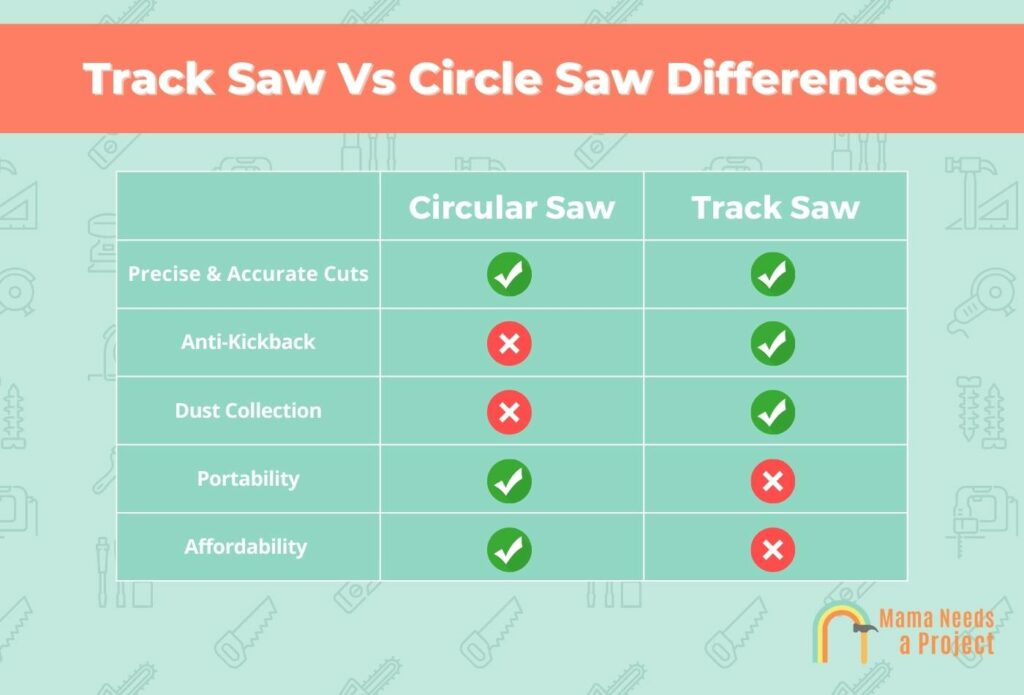
What Is a Circular Saw?
A circular saw is a powerful cutting tool that features a spinning metal-toothed circular blade that cuts through wood with ease.
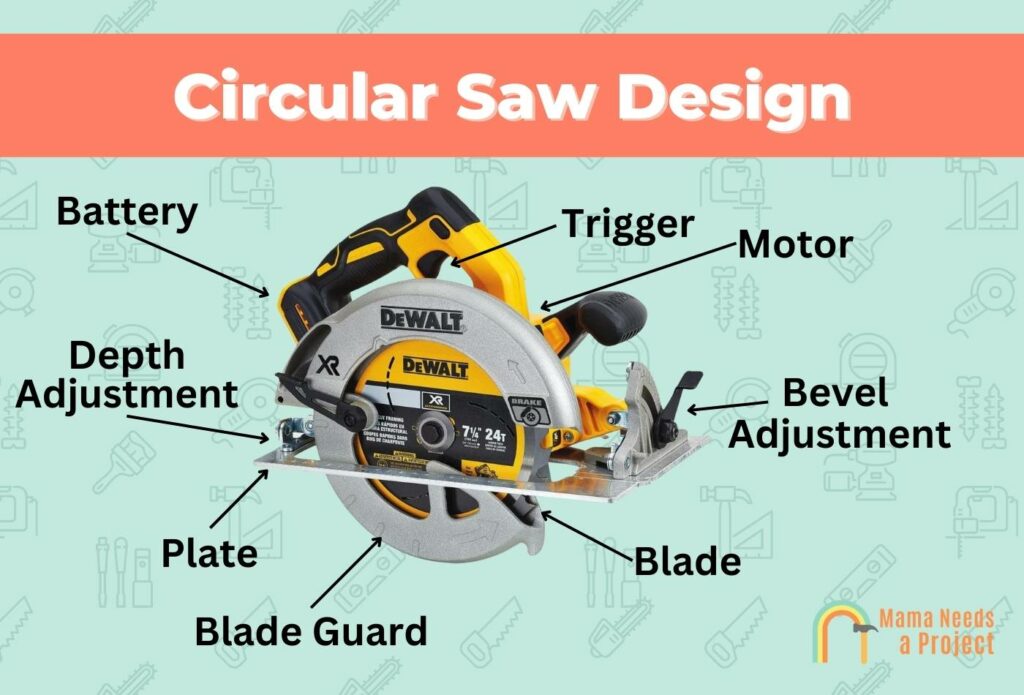
You can find both table-mounted circular saws and handheld circular saws, but in this article the handheld model is what I’ll be referring to.
A circular saw blade can spin 3,000 to 50,000 times per minute, which is why these saws are able to cut through a wide range of materials without issue.
They can cut timber, lumber, MDF, cork board, PVC, concrete board, and paneling (just to name a few materials). There are also specially designed blades that allow a circular saw to cut through sheet metal.
Adjusting the saw’s cut depth is simple, and circular saws are even able to make bevel cuts.
Benefits of Circle Saws
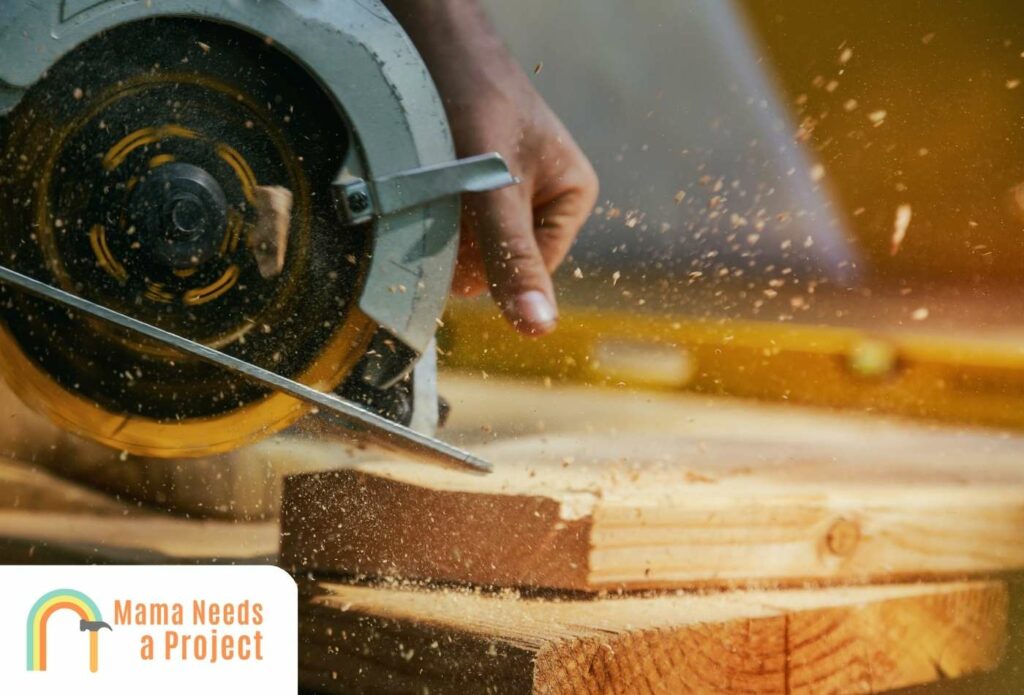
1. Versatility
The versatility of circular saws is a key reason why many people prefer these saws. Circular saws can make both shallow and deep cuts through a wide range of materials, and they can deliver beveled cuts, perform cross-cutting, and cut straight edges.
2. Portability
Handheld cordless circular saws are highly portable, which means you can transport them easily and safely. They are extremely quick to setup and start making cuts on the go. Compared to table saws and other stationary saws, circular saws are much more portable and easy to store.
3. Clean, Precise Cuts
Circular saws are great at delivering precise, accurate cuts. That said, how a circular saw cuts is in large part influenced by how the user handles it. So if you’re an experienced woodworker you might have no problem using a regular circular saw to cut straight lines. However, if you’re a beginner using a circular saw, it might be more difficult. (That’s why I put together this list of circular saws for beginners!)
Most circular saws are user-friendly and easy to handle after you’ve had some practice.
Check out this table saw vs band saw comparison to learn which saw is best for you!
4. Speed
Circular saws are much faster than miter and jigsaws, which is why they’re a go-to tool for those who often need to complete cutting jobs quickly.
And if you want to make a circular saw cut even faster, equip it with a carbide-tipped blade.
Wondering how to use a circular saw? Check out the video below!
Drawbacks of Circle Saws
1. Not the Best for Metal and Durable Materials
While a circular saw is powerful, if you’re mostly going to be cutting metal or other durable materials, you should choose a stronger power saw.
Circle saws can be either corded, or cordless. Cordless saws might not be capable of delivering the power you need to cut through tough materials.
2. Kickback
You could also experience a fair bit of kickback when using a circular saw because of the lack of a riving knife.
Kickback is when you’re sawing and the blade kicks up a shard of material in your direction. This can be dangerous, especially if you’re not wearing the proper safety gear.
3. Loud & Messy
Many circular saws are loud and messy.
Since they don’t have a dust bag, you could breathe in a considerable amount of sawdust while sawing – which is extremely annoying.
These tools are also quite loud, creating a high-pitched screech as they cut.
What Is a Track Saw (Or Plunge Saw)?
Track saws and circular saws essentially utilize the same blades, but track saws—unlike circular saws—cut along a track to ensure a straight and precise cut.
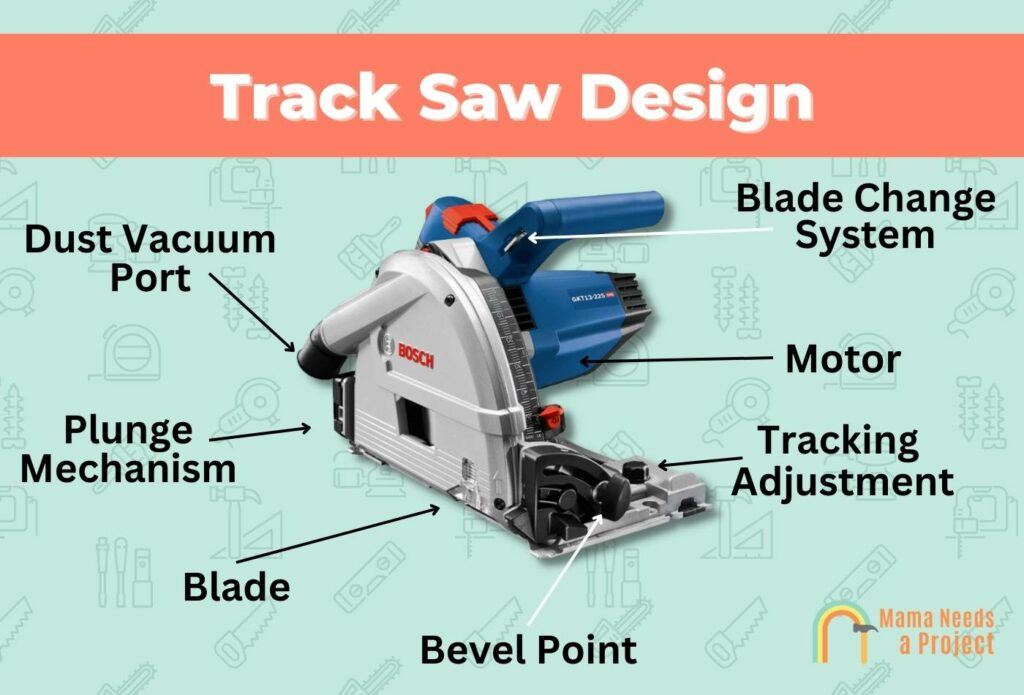
Both the circular saw and track saw feature a circular blades that can make a wide range of cuts.
Simply put, to cut with a track saw, all you have to do is put the edge of the track against the cutting line and turn the machine on. The saw will cut along the track until you stop it or there’s nothing left to cut. It’s that easy.
Track saws can feature both corded and cordless models, though a corded model will offer more power.
When comparing a track saw vs circular saw – there are a few differences you should consider.
Benefits of Track Saws
1. Superior Dust Collection
To ensure sawdust that’s kicked up from cutting doesn’t inhibit you from cutting or damaging the saw, track saws include a dust-collection bin or port.
If you hook a vacuum up to your track saw, you can enhance its dust-collecting capability and avoid saw dust in your face.
2. Exact Cut
If you’re using a track saw, you don’t need to spend a ton of time measuring or doing guesswork before cutting thanks to its track.
The plastic guiding line these saws have will show you where the blade is going to cut, which means you don’t have to waste time completing test cuts.
Simply line up the guiding line on the track saw with the cutting line on your material and begin cutting.
3. Clean Cuts
Track saws tend to deliver smoother cuts than circular saws because track saws move in a straight, predetermined line, whereas circular saws rely heavily on handling.
Put differently, if you apply too much pressure, you’ve got shaky hands, or the material isn’t fastened when you’re using a circular saw, it’s likely the result won’t be a smooth edge.
Want to learn how to use a track saw? Check out the video below!
Drawbacks of Track Saws
1. Works Best on Smooth Wood
The entire track must be stuck to the material in order for the saw to cut precisely in a straight line. If any part of the track isn’t stuck, the saw could wobble while cutting, leaving a jagged edge.
For this reason, cutting unfinished wood with a track saw is difficult and won’t yield the best finish. So you might want to avoid cutting low-grade plywood with a track saw.
2. Not Good for Flimsy Materials
The material you’re cutting should be stiff enough to support the weight of the track saw. If you’re cutting foam board, for example, you’ll need something supporting this material underneath so the saw can cut properly.
3. Tough to Operate in a Confined Space
Track saws are operable in most small spaces, but working in an especially small space may be tough, as it’s likely you won’t have enough space to put the whole track down.
When Should You Use a Circular Saw?
Making Different Cuts
A range of cuts can be made by a circular saw, including cross cuts, rip cuts, punch cuts, plunge cuts, miter cuts, and bevel cuts.
- Cross Cuts – To make a precise cross cut, you’ll need a block of some kind to press the foot of the saw up against. The foot, sometimes called the shoe, is a metallic, rectangular rim that goes around the saw blade. It should be flat all the way around and the long sides should be parallel to the blade. If you don’t use a block or something similar when making cross cuts, you won’t have something firm guiding the saw, which means the saw slipping is more likely.
- Rip Cuts – A circular saw can make precise rip cuts as well provided you have a rip fence. This attachment slides into the foot of the saw and is mounted in place with screws.
- Punch Cuts – Circular saws are also great at making punch cuts. If you can’t cut at the end of the board, you’ll need to press the front of the saw’s foot against the surface at an angle. When you’re ready to cut, turn on the saw and slowly lower the blade until it begins cutting material. Stop when you reach the desired depth.
- Miter Cuts – Making miter cuts with a circular saw is a breeze too. Of course you could make these with a miter saw, but these are more expensive and much less versatile. So if you have to cut wood at an angle infrequently, it’s best to have a circular saw.
- Bevel Cuts – Making bevel cuts with a circular saw is easy and doesn’t take a lot of time. But you’ll probably need clamps to do this effectively, as well as tools for drawing and measuring.
Jobs That Call for a Circular Saw

1. Cutting Molding
Using a circular saw and a speed square, you can cut molding. Simply clamp the speed square to the molding to ensure you cut at a 45° or 90° angle.
This isn’t the simplest way to cut small molding, but using a cross-cut blade will make the job easier.
2. Cutting Doors
Circular saws are also great at cutting doors. Just make sure you’re using a saw that has at least 18 teeth.
When using a circular saw to cut a door, be careful, as trimming too much off the door could make it inoperable or visually unappealing.
3. Cutting Countertops
Need to cut through countertops? A circular saw can cut through countertops quickly and easily. And don’t forget to use a clean, sharp blade so you don’t have to deal with a lot of kickback.
If you’re worried about chipping the wood, make sure you use a blade that has a lot of teeth; you can also put tape along the cutting line to help ensure a chip-free cut.
4. Cutting Logs
The circular saw is also a go-to tool for those who need to turn logs into firewood.
This kind of woodworking is best done outside, as a lot of sawdust will be produced. Plus, since logs usually have bark, the risk of kickback is higher.
And when you’re using a circular saw to make firewood, it’s important to keep track of how much you’re running the tool and the temperature of the blade. If you overheat the system or the blade, you could damage several components and render the tool inoperable.
When Should You Use a Track Saw?
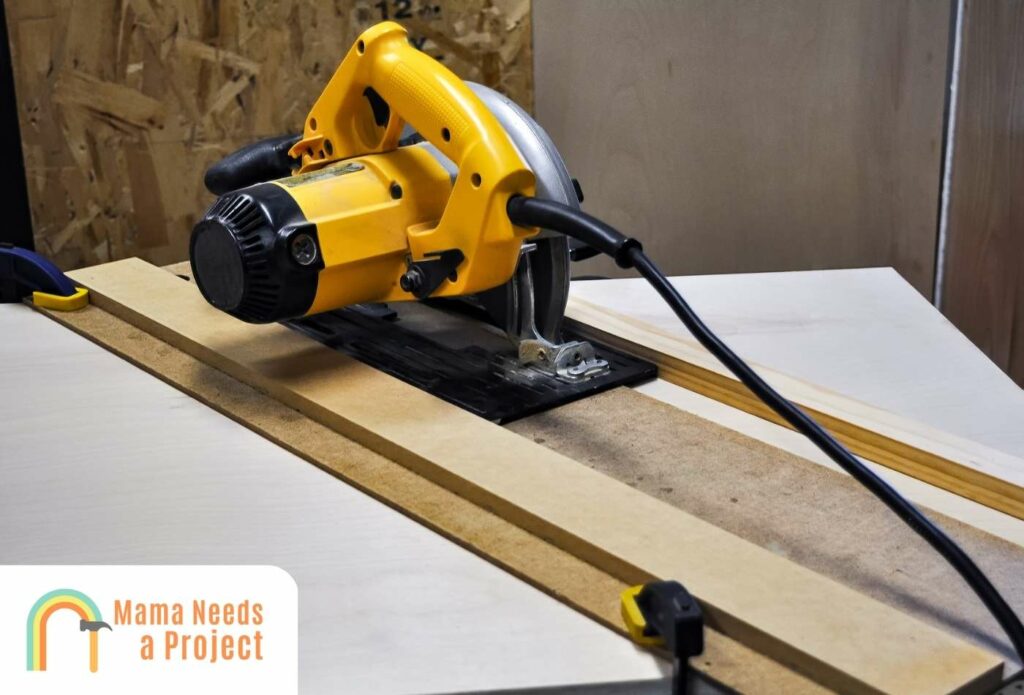
A track saw can make all the cuts a circular saw can make, though making plunge cuts can be a bit difficult because of the track.
But when it comes to cross cutting and rip cutting, you can argue that the track saw is superior to the circular saw because it’s guided by a firm, straight edge, whereas a circular saw relies on handling.
You can make angled cuts with a track saw too, provided you line the track up properly.
One of the best things about the track saw is it can deliver a smoother edge, in large part because the adhesive under the track acts like tape, securing the material along the cutting line.
Jobs That Call for a Track Saw
1. Cutting Plywood
Cutting finished plywood is a breeze with a track saw. All you have to do is lay the track along the cutting line and then turn the saw on.
You may even be able to cut multiple sheets of plywood at once, provided they’re thin.
Using a track saw to cut boards saves a lot of time, as you won’t have to worry about lining up the saw precisely each time you go to cut a board. Cutting time is quicker too, as the saw moves on its own.
2. Making Long Cuts
If you need to make a particularly long cut, all you have to do is attach several tracks. The saw will run along the entirety of the track without negatively affecting the cut.
You just have to make sure you’re using the same track all the way through. This way of cutting is good if you have to cut a particularly long board or flooring.
3. Cutting in a Confined Space
Say you have to do some cutting in a confined space—a closet, for example. Working with a circular saw can be difficult since there’s not a lot of space to move around, but this isn’t the case if you’re relying on a track saw.
All you have to do is get the track fastened and the saw will take care of the rest. Of course you will need to guide the saw a little bit, especially when it’s near the end of the track.
Since the track does most of the guide work, you don’t have to worry about holding the saw awkwardly or applying the wrong amount of pressure at the wrong time.
FAQ
Can any circular saw be used as a track saw?
Not every circular saw can be equipped with a track. This is mainly because some circular saws are designed in a way that makes attaching a track impossible.
That said, most circular saws can utilize a track. It’s best to use a circular saw and track that are made by the same manufacturer; this way there’s seamless compatibility.
What can’t a track saw do?
The track saw is good for a variety of reasons, but if you’re cutting a small piece of material or you have to do a cut that’s deeper than 2 inches, you’ll find the track saw to be inadequate.
Some materials that a track saw can cut are more efficiently cut using a table saw. But if you don’t have the latter tool because it’s too expensive or you don’t have space for it, using a track saw is the way to go—but it will take longer.
Can you cut a 2×4 with a track saw?
Yes, you can cut a 2×4 with a track saw.
Final Thoughts
So which is superior: the circular saw or the track saw? The truth is, both saws are great at cutting wood and other materials.
The track saw is a great tool if you need a bit of guidance when cutting, and the circular saw is a powerful, versatile tool that can deliver a range of cuts easily.
The main differences between the two tools is how you hold them and the accuracy offered.

